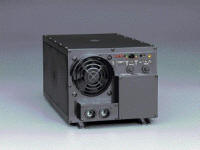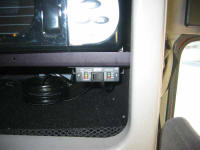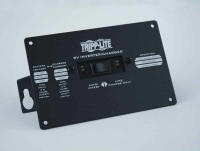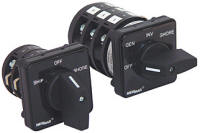
Please wait, I'm coming over...

Last Changed 9/7/2007 |
||
|
We chose an Inverter/Charger to provide for battery charging while
on shore power (plugged into electricity). A side benefit is that
the AC wiring is simplified. |
||
 |
We chose a Tripp-Lite APS2012 2000watts Inverter/Charger. It can
supply up to 2000 watts continuously with a burst mode up to 4000
watts. As a battery charger. it can charge at 25 amps or 100 amps. This is a microprocessor controlled charger that rapidly but safely charges the batteries to top off and holds them there with overcharging. This charging power has been useful to recovery the truck batteries when I accidentally had let them run down. Cost was one of the driving factors for choosing the Tripp-Lite. It was a couple of hundred dollars less than the traditional RV Inverter/Chargers. |
|
 |
||
click on image to enlarge |
||
Note - while I feel that the Tripp-Lite APS2012 Inverter/Charger is a fine unit, I cannot say the same for Tripp-Lite support. I managed to damage the remote control for the Inverter/Charger. When I asked for assistance from Tripp-Lite via email, the responses ran from no response to some of the inquiries to a useless response that ignored all the information submitted describing the problem. perhaps the Tripp-Lite telephone support is better. Too bad because it is a good unit. With a plain inverter, we would have had to make some arrangement to connect the outlets within the cab to the inverter or the shore power receptacle, but not both at the same time. If both the shore power receptacle and the inverter were connected to the outlets at the same time, two problems could occur. First, if there was no shore power cable in the receptacle, the receptacle would be live with 110 volts from the inverter, a serious hazard. Second, if the shore power cable is in the receptacle, then the inverter would be contending with the shore power and that could be disastrous to the inverter. The normal solution for this is a switch that swings the outlets to one power source to the other. The Tripp-Lite APS2012 Inverter/Charger does the switching automatically. If the shore power cable is live, then the Inverter/Charger feeds the AC power through to the outlets and puts DC power to the batteries to charge them. In the absence of shore power AC, the inverter creates AC power from DC power from the batteries. The process is automatic |
||
 |
One of the advantages of the Tripp-Lite APS2012 Inverter/Charger is
the availability of a Remote Control. The APSRM4 is usable with
several models of Tripp-Lite Inverter/Chargers. We mounted the APSRM4 Remote Control for the Tripp Inverter under the shelf holding the microwave. This put the control in an easy location to see and operate. The APSRM4 Remote Control allow the APS2012 Inverter/Charger to be mounted in the Electrical Compartment and still be controlled. The APSRM4 also has a capability to connect a control cable from the ignition switch that either turns the Inverter function with the ignition on, or disables the Inverter function when the ignition is on. We did not use this function at first but we added it later to turn the Inverter function on and off with the ignition because we forgot to turn the Inverter off too many times. By experience, we found that we had to connect the input AC circuit to the truck only to the Inverter through the circuit breakers. We had connected the neutral wire to the neutral bus but that would cause GFCI breakers to pop when we plugged in the truck. We had bypassed the in-built neutral connection mode. |
|
 |
||
click on image to enlarge |
||
There are some excellent write-ups on RV Genset and Inverter wiring on Jack Mayer's website. |
||
 |
We used a double pole circuit breaker on the shore power AC feed to the inverter. This is a practice we learned from our boating days. By having a circuit breaker on the hot and the neutral lead, you protect the AC wiring from having the possible hazard of a crossed wired outlet that you plug the shore power cable into. This is an extremely rare situation but the cost is high if it happens. Having the hot lead connected to the neutral lead of the power cord will result in the hot lead also being connected to ground, a direct short circuit. The circuit breaker on the neutral lead will prevent internal wiring taking the brunt of the short circuit. | |
click on image to enlarge |
||
There is an advantage to using an inverter/charger over just an inverter and connecting shore power to the output of the inverter. If you use a plain inverter and connect the shore power to the output of the inverter, you will have a live input outlet when you are running on the inverter. This is a very hazardous situation. The inverter/charger with automatically connect the internal AC wiring to shore power when it is present and disconnect the shore power inlet when running on the inverter function. This is far safer. Some will try to use a circuit breaker to manually disconnect the shore power inlet when running on the inverter. This relies on human memory to flip this breaker when the inverter is turned on, a risky proposition. If this route is attempted, then a dual pole breaker should be used as described above. There is another problem with the manual disconnect method. The proper place to tie the AC neutral to ground is as close to the power source as possible. When running on the inverter, the inverter is the power source and the neutral should be tied to ground at the inverter. When running on shore power, the source is the power plant and neutral should be tied to ground at least as far back as the main power distribution panel for the park or house. Within the truck, AC neutral should not be tied to ground. By nature, the inverter will have its neutral tied to ground. To prevent the incorrect tying of neutral and ground , the inverter needs to isolated from the truck AC wiring. So now you need a set of breakers for the invert and a set of breakers for the shore power and you have to remember only to have one set of breakers closed at a time. |
||
 |
If you want to use a plain inverter, the next best thing is to use a transfer switch. These are typically found on boats to transfer the boat's AC wiring from shore power to an onboard generator. The advantage of the transfer switch is that only one source (shore power or inverter) can be connected through mechanical separation. These transfer switches can be wiring to solve the neutral to ground wiring. These switches are not low cost but safety should always be considered. | |
click on image to enlarge |
||
Disclaimer: The information in this site is a collection of data we derived from the vendors and from our personal experiences. This information is meant as a learning guide for you to make your own decisions Best practices and code should always be followed. The recommendations we make are from our personal experiences and we do not receive any compensation for those recommendations. |